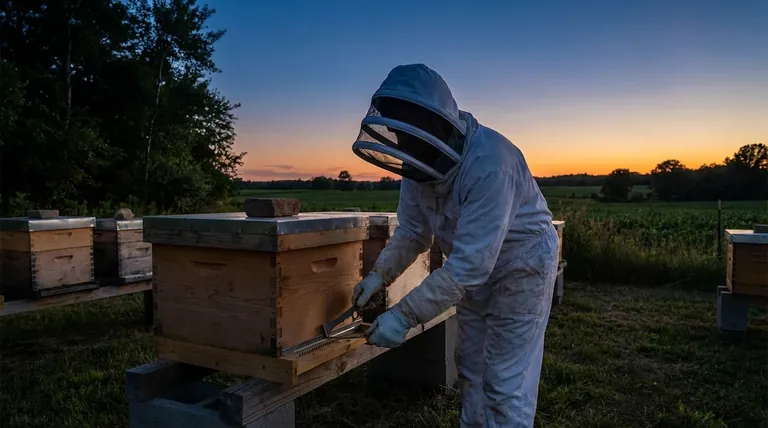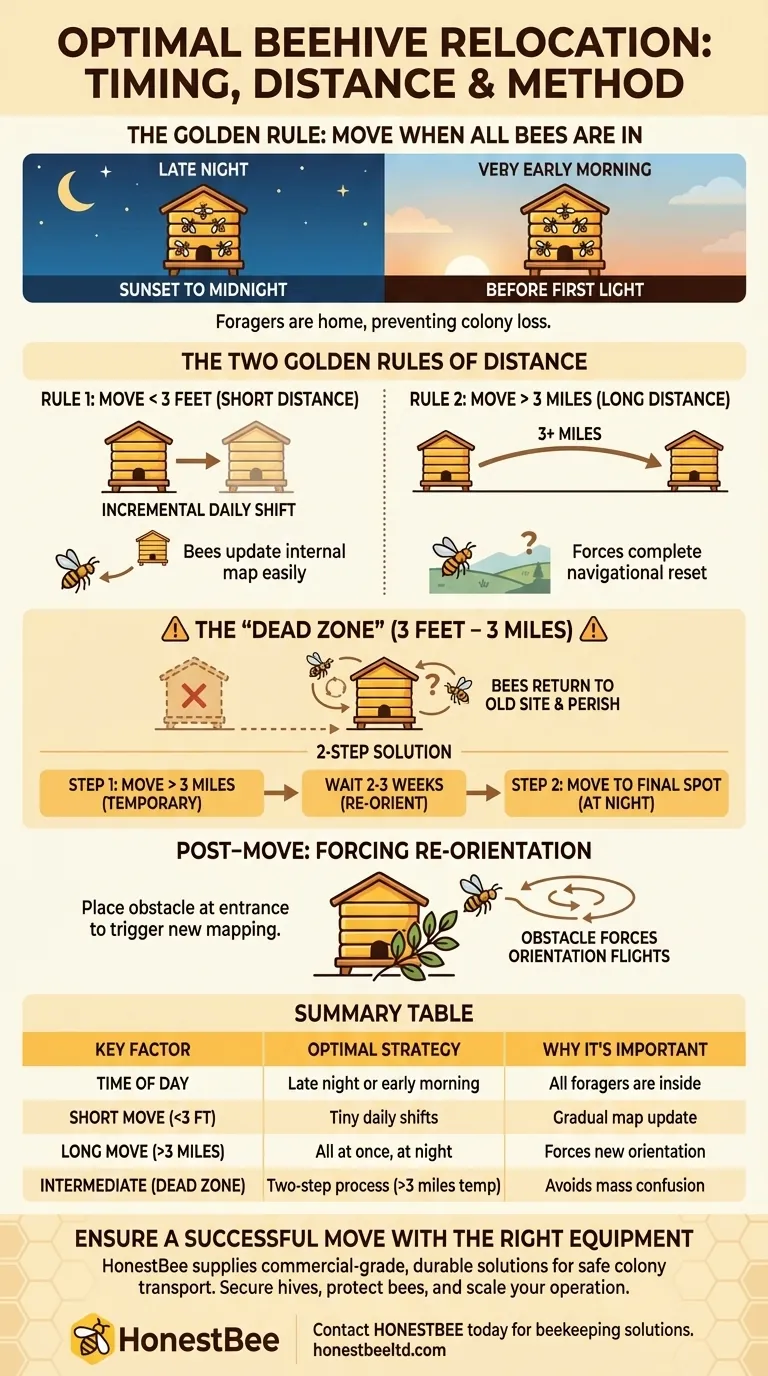The optimal time to move a beehive is when the entire colony is inside, which occurs either late at night after the sun has set or very early in the morning before sunrise. During this period, the foraging bees have returned from their daily work and are settled for the night. Moving the hive with the entrance securely sealed at this time ensures you are moving the full strength of the colony and will not leave any bees behind.
Moving a beehive is not just about the time of day; it's about respecting the bees' powerful sense of location. A successful move minimizes disorientation by ensuring every bee is accounted for and then forcing them to re-evaluate their surroundings at the new site.

Why Night Moves are Non-Negotiable
A honeybee colony operates with remarkable efficiency, and this system is anchored by the bees' internal navigation. Understanding this is key to a successful move.
The Forager Bee's Internal GPS
Forager bees, which are the older bees that collect nectar and pollen, leave the hive each day and perform orientation flights. During these flights, they map the precise location of their hive relative to the surrounding landscape.
This "GPS" is incredibly accurate. If you move the hive while they are out foraging, they will return to the exact spot where the hive used to be, not to its new location.
The Consequence of a Daytime Move
Moving a hive even a few yards during the day will strand thousands of forager bees. They will fly in confused circles at the original site until they perish.
Losing your entire foraging workforce is devastating to a colony's ability to collect resources, raise brood, and defend itself. This is the primary reason all moves must happen when they are safely inside.
The Two Golden Rules of Distance
The success of your move also depends critically on how far you plan to take the hive. The rules are surprisingly rigid and are based on the bees' navigational memory.
Rule 1: Move Less Than 3 Feet
For very short-distance adjustments within the same yard, you can move the hive a tiny amount each day.
By moving it no more than a few feet at a time, the returning foragers can still find the entrance. They notice the slight shift and update their internal map without significant confusion.
Rule 2: Move More Than 3 Miles
A move of three miles or more is far enough to completely reset the bees' navigation. When they emerge in a totally new environment, their old map is useless.
This forces them to perform new orientation flights and map their surroundings from scratch. They have no memory of the old location to return to, so the entire colony stays together.
Understanding the Trade-offs: The "Dead Zone"
The most common mistake beekeepers make is moving a hive a distance between 3 feet and 3 miles. This creates maximum confusion.
The Problem with a 100-Yard Move
If you move a hive 100 yards away, it is too far for the bees to easily find, but it's still within the familiar territory of their old GPS map.
Returning foragers will recognize the general landscape and fly directly to the original hive location. A small percentage may eventually find their way to the new spot, but the vast majority of your field force will be lost.
How to Navigate the Dead Zone
If you absolutely must move a hive to a final spot within this "dead zone," the only safe method is a two-step process.
First, move the hive more than 3 miles away to a temporary location for at least two to three weeks. After they have fully re-oriented to that yard, you can then move them again (at night) to your desired final location.
Post-Move: Forcing Re-orientation
Even when following the rules, you must take steps to ensure the bees register the change and don't immediately leave the hive on their old flight paths.
Placing an Obstacle
The most effective technique is to place a leafy branch or a pile of grass directly in front of the hive entrance after you move it.
When the bees emerge the next morning, this obstacle forces them to stop, hover, and re-orient. They will immediately notice that their surroundings are different and will begin to perform new orientation flights.
When to Open the Hive
After arriving at the new location, you can open the hive entrance early the next morning, just before first light. Ensure your re-orientation obstacle (like a branch) is in place before you do.
Making the Right Choice for Your Goal
Your moving strategy is dictated entirely by the distance.
- If your primary focus is a small adjustment in your yard: Move the hive no more than 3 feet per day, allowing the colony to adapt incrementally.
- If your primary focus is relocating the hive to a new property: Move it over 3 miles away, all at once and only at night, to force a complete navigational reset.
- If your primary focus is an intermediate move (e.g., to the other side of your property): Use the two-step method by first moving it 3+ miles away for several weeks before bringing it back to the final spot.
A well-planned move ensures the safety and stability of your colony, setting them up for continued success in their new location.
Summary Table:
| Key Factor | Optimal Strategy | Why It's Important |
|---|---|---|
| Time of Day | Late at night or very early morning | Ensures all forager bees are inside the hive, preventing them from being stranded. |
| Short Move (<3 Feet) | Move the hive a tiny amount each day. | Allows bees to gradually update their internal map without confusion. |
| Long Move (>3 Miles) | Move the hive all at once, at night. | Forces bees to perform new orientation flights in a completely unfamiliar area. |
| Intermediate Move (Dead Zone) | Use a two-step process: move >3 miles away temporarily, then to the final spot. | Avoids mass confusion and loss of bees by resetting their navigation first. |
Ensure Your Beehive Move is a Success with the Right Equipment
Relocating a colony is stressful for both the beekeeper and the bees. Having reliable, well-designed equipment is crucial for a safe and secure move. HONESTBEE supplies commercial apiaries and beekeeping equipment distributors with high-quality, durable supplies built to protect your valuable colonies during transport and beyond.
We can help you:
- Secure Hives for Transport: Our sturdy straps and hive stands ensure stability.
- Protect Your Bees: Quality materials and precise construction keep your colony safe.
- Scale Your Operation: Wholesale-focused operations mean we can meet the demands of growing businesses.
Let's discuss your apiary's needs. Contact HONESTBEE today for durable, commercial-grade beekeeping solutions.
Visual Guide

Related Products
- HONESTBEE Advanced Ergonomic Stainless Steel Hive Tool for Beekeeping
- Professional Dual-End Stainless Steel Hive Tool for Beekeeping
- HONESTBEE Professional Long Handled Hive Tool with Precision Cutting Blade
- Wholesales Dadant Size Wooden Bee Hives for Beekeeping
- HONESTBEE Professional Multi-Functional Hive Tool with Ergonomic Wood Handle
People Also Ask
- Why is it important to compare the progress of different hives? A Beekeeper's Key Diagnostic Tool
- How should beekeepers handle bees when using a hive tool? Master Calm, Deliberate Techniques
- What are the features of a regular hive tool? The Essential Multi-Tool for Every Beekeeper
- What are the basic tools for beekeeping? Essential Starter Kit for Safe & Successful Hive Management
- How is a hive tool used for scraping and cleaning? Master Hive Maintenance for a Healthy Colony



















